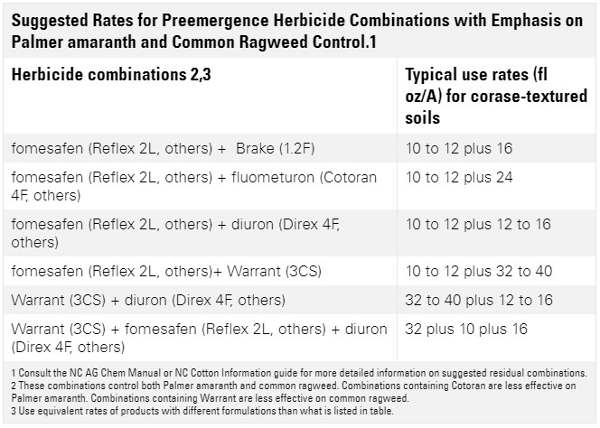By Charlie Cahoon
As harvest 2018 wraps up, I understand it’s hard to think about 2019. But, seed orders are being place, so I ask you to consider your weed management for the coming year. “Start Clean, Stay Clean” has been the consistent message from extension weed specialists since the development of glyphosate-resistant Palmer amaranth. The “Start Clean” part of this mantra most often includes an early preplant burndown application of Roundup (glyphosate), 2,4-D, and Valor (flumioxazin) followed by Gramoxone (paraquat) plus residual herbicide(s) at-planting. Although there are only a few single active ingredients labeled preemergence at-planting for cotton, producers have some great tools at their disposal, especially if they consider a tank mixture of two or more residual products.
The difference between a weak PRE (left) and a strong combinations of residual herbicides (right) can drastically change plans for in-season weed management.
In the wake of herbicide-resistance, it was discovered that herbicide combinations of two or more modes of action with overlapping spectrums of control are useful in resistance management. It’s just a numbers game. The chances of having a weed within the population resistant to both modes of actions is much less than having a weed resistant to a single mode of action. Overlapping spectrums of control means both products in the mixture are effective against the target weed. For example, Reflex (fomesafen) and Direx (diuron) both control Palmer amaranth, hence their spectrums of control overlap for this weed. With that said, I have highlighted a few residual herbicide combinations in the table below with emphasis on Palmer amaranth and common ragweed control. One of these combinations should serve as the foundation for your 2019 cotton weed management. Before we get to the table, I want to clarify a few points. 1) The suggested rates below are ONLY for combinations. For example, Reflex is suggested at 10 to 12 oz/A in combination Brake (fluridone), Cotoran (fluometuron), Direx (diuron), and Warrant (microencapsulated acetochlor). Used alone, Reflex should be applied at 16 oz/A. However, due to injury concerns most folks do not apply 16 oz/A. If using rates less than suggested by the manufacturer, it would be wise to include a tank mix partner, again with a similar spectrum of weed control. 2) Alternative formulations or generics are available for many of the products listed below. Be sure to use equivalent rates of products with different formulations than what is listed in table. And 3) these combinations control both Palmer amaranth and common ragweed. However, combinations containing Cotoran are less effective on Palmer amaranth whereas combinations containing Warrant are less effective on common ragweed. Lastly, please consult the North Carolina Agriculture Chemical Manual or North Carolina Cotton Information guide for more detailed information on suggested residual combinations.
